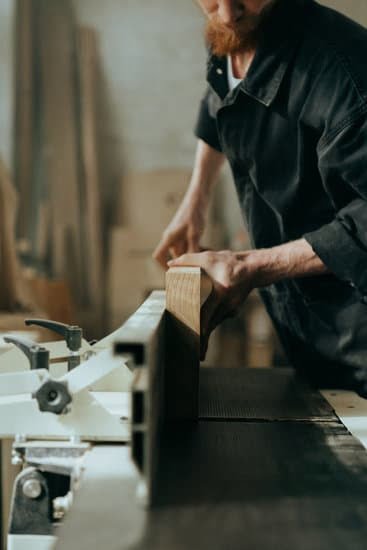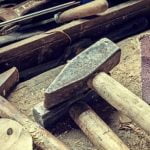Are you looking to add a professional touch to your woodworking projects? This article will guide you on how to miter corners in woodworking, providing you with the knowledge and techniques to achieve perfect miter joints. Understanding the basics of miter joints, identifying the necessary tools and materials, measuring and cutting mitered corners, joining techniques, finishing touches, and common mistakes to avoid are just some of the topics we will cover in this comprehensive guide.
Mitered corners are a popular choice in woodworking as they create a seamless and elegant look by joining two pieces of wood at an angle. Whether you are working on picture frames, furniture, or decorative trim, mastering the technique of creating miter joints will take your woodworking skills to the next level.
By following our step-by-step instructions and incorporating our tips and tricks for achieving perfect miter joints, you’ll be able to elevate the quality of your woodworking projects.
In this article, we’ll walk you through each stage of creating mitered corners, from understanding the basics of miter joints to finishing and sanding for a professional look. We will also highlight common mistakes that beginners often make when mitering corners and provide inspiration for your next woodworking project. So let’s dive into the world of miter corners in woodworking and learn how to achieve flawless results every time.
Understanding the Basics of Miter Joints
What Are Miter Joints?
Miter joints are a type of woodworking joint that is formed by joining two pieces of wood together at an angle. Unlike butt joints, where the ends of the two pieces of wood are simply butted together, miter joints create a clean and seamless corner. The angle at which the two pieces come together is typically 45 degrees, although other angles can be used depending on the project.
Benefits of Using Miter Joints
Miter joints are popular in woodworking because they create a visually appealing and professional-looking corner. When executed properly, miter joints can make a project look seamless and polished. They are often used in picture frames, door and window casings, crown molding, and other decorative trim work. Mitered corners also provide strength to the overall structure of the piece when reinforced with proper joinery techniques.
Challenges of Miter Joints
While miter joints add elegance to woodworking projects, they also present some challenges. One such challenge is achieving precise cuts at perfect angles to ensure that the joint fits together seamlessly. Additionally, because mitered corners have less gluing surface compared to other types of joints, it’s important to reinforce them properly to ensure their durability over time. In the next section, we will delve into how to measure and cut mitered corners effectively in woodworking projects.
Tools and Materials Needed for Miter Corners
When it comes to creating miter corners in woodworking, having the right tools and materials is essential for achieving a professional and polished result. Whether you’re working on a simple picture frame or a more complex furniture piece, there are some key items you’ll need to have on hand.
First and foremost, you will need a miter saw, which is specifically designed for making precise angled cuts. This tool is crucial for achieving clean and accurate miter joints. Additionally, a table saw can also be used for cutting mitered corners, especially for larger or thicker pieces of wood.
In addition to the saws, you’ll also need measuring tools such as a combination square or a bevel gauge to accurately measure and mark the angles for your miter cuts. A sharp pencil or marking knife will also come in handy for clearly marking your cut lines.
Furthermore, having quality clamps to hold your pieces securely in place while cutting and joining the mitered corners is important for achieving tight and seamless joints. Finally, don’t forget about the necessary safety equipment such as eye protection and hearing protection when operating power tools.
As you can see, having the right tools and materials is crucial when it comes to mastering how to miter corners in woodworking. By ensuring that you have these essentials at your disposal, you’ll be well-equipped to tackle any project that requires precision miter joints.
Step-by-Step Guide on How to Measure and Cut Mitered Corners
Measuring and Marking the Corners
To achieve perfectly aligned mitered corners, accurate measurements are crucial. Start by placing the two pieces of wood that will form the corner together, ensuring they are properly aligned. Use a square to mark a line where the cut should be made on both pieces of wood. For inside corners, measure from the long point of the miter to the short point. For outside corners, measure from short point to short point.
Cutting the Mitered Corners
Once you have marked the lines for cutting, it’s time to use your saw to make the cuts. A miter saw is ideal for this task as it can easily adjust to different angles. Set your miter saw to a 45-degree angle and carefully cut along the marked lines on each piece of wood. It’s important to ensure that the angles are exactly 45 degrees for each piece so that they fit together seamlessly.
Checking Your Work
After cutting both pieces at a 45-degree angle, it’s important to check if they fit together perfectly. Place them together and inspect the joint – there should be no gaps between the two pieces when they are joined at a perfect 90-degree angle.
If there are any imperfections, re-cutting or sanding may be necessary to achieve a clean and tight mitered corner joint. Double-checking your work before proceeding is key to achieving professional results in woodworking projects.
Tips and Tricks for Achieving Perfect Miter Joints
Achieving perfect miter joints in woodworking requires precision and attention to detail. Here are some useful tips and tricks to help you achieve flawless mitered corners for your woodworking projects:
- Use a High-Quality Miter Saw: A good quality miter saw with sharp blades is essential for achieving clean and accurate cuts. Make sure the saw is properly calibrated for precise angles.
- Accurate Measurement: Proper measurement is crucial for perfect miter joints. Use a reliable measuring tool such as a combination square or a digital angle gauge to ensure accuracy.
- Test Cuts: Before cutting your actual workpiece, it’s a good idea to make test cuts on scrap wood. This will allow you to fine-tune your technique and ensure that the angles are correct.
Techniques for Sanding Mitered Corners
In addition to precise cutting, sanding plays a crucial role in achieving smooth and seamless miter joints. Here are some techniques for sanding mitered corners:
- Use Sanding Blocks: Utilize sanding blocks or pads to maintain flat, even surfaces on the mitered corners. This will help prevent rounding of the edges while sanding.
- Progressive Grits: Start with a coarser grit sandpaper to remove any rough edges or imperfections, then gradually move on to finer grits for a smooth finish.
- Polymer Sanding Pads: Consider using polymer sanding pads, which conform well to angled surfaces and can help achieve consistent results on mitered corners.
By following these tips and employing proper techniques, you can enhance the precision and quality of your mitered corners in woodworking projects.
Remember that practice makes perfect, so don’t be discouraged if you don’t achieve flawless results on your first attempt. With patience and perseverance, you’ll soon master the art of creating perfect miter joints in your woodworking endeavors.
Joining Mitered Corners
Once you have successfully cut your mitered corners, the next step is to join them using gluing and clamping techniques. Properly joining mitered corners is essential to ensure a strong and durable woodworking project. The glue and clamps help to hold the joints together while the glue sets, creating a seamless finish.
To start, apply a thin, even coat of wood glue to both mitered surfaces that will be joined together. It’s important to use a high-quality wood glue that dries clear and is suitable for the type of wood you are working with. Using a small brush or even your finger, spread the glue evenly along the entire mitered edge.
Once the glue has been applied, carefully align the mitered corners and gently press them together. It’s crucial to ensure that the corners are perfectly aligned before proceeding to clamp them. Use woodworking clamps to hold the joined corners securely in place while the glue sets.
Be sure to wipe away any excess glue that may squeeze out from the joint as you clamp it down. The clamps should remain in place until the glue has fully cured according to the manufacturer’s instructions.
By following these gluing and clamping techniques, you can achieve strong and professional-looking mitered corners in your woodworking projects. Remember that patience is key when working with wood glue, and allowing ample time for the glued joints to set will result in a sturdy and long-lasting finished product.
Finishing and Sanding Mitered Corners for a Professional Look
Once you have successfully cut and joined your mitered corners, the next step is to finish and sand them to achieve a professional look. Proper finishing and sanding will not only enhance the appearance of your woodworking project but also ensure that the joints are smooth and seamless.
To begin, gather the necessary materials for finishing such as wood stain or paint, brushes, rags, and any protective finishes you may need. When selecting a wood stain or paint, consider the type of wood you are working with and choose a color that complements the overall design of your project.
After applying your chosen finish, allow it to dry completely before sanding the mitered corners. Start with a low grit sandpaper to remove any excess finish or rough edges, then gradually move to higher grit sandpapers for a smoother finish. Be sure to sand in the direction of the wood grain to avoid leaving visible scratches on the surface.
For an even more professional look, consider using wood filler to fill in any small gaps or imperfections at the mitered corners before finishing and sanding. This will help create a seamless transition between each piece of wood and give your project a polished appearance.
The finishing and sanding process is crucial in achieving flawless mitered corners in woodworking. Taking the time to properly finish and sand your joints will result in a high-quality final product that you can be proud of. Remember to pay attention to detail throughout this process for best results.
| Materials | Tools |
|---|---|
| Wood stain or paint | Sandpaper (low to high grit) |
| Brushes and rags | Wood filler (optional) |
Common Mistakes to Avoid When Mitering Corners
Mitering corners in woodworking can be a challenging task, but when done correctly, it adds a professional and polished look to your project. However, there are common mistakes that woodworkers often make when mitering corners, which can compromise the overall quality of the finished piece. By being aware of these pitfalls and knowing how to avoid them, you can ensure that your mitered corners turn out perfectly every time.
One common mistake when mitering corners is not properly preparing the wood before making the cuts. It’s essential to ensure that the edges are straight and free from any imperfections before attempting to create a miter joint. Failing to do so can result in uneven joints and gaps in the finished piece.
Another mistake to avoid is inaccurately measuring and cutting the angles for the miter joints. Even a slight error in angle measurement can lead to poorly fitting corners. Taking the time to double-check your measurements and using a reliable miter saw or miter box will help you achieve precise cuts for seamless joints.
Finally, rushing through the gluing and clamping process can also lead to mistakes when mitering corners. Applying too much or too little glue, as well as not using enough clamping pressure, can result in weak joints or misalignment. It’s important to follow proper gluing and clamping techniques, allowing sufficient time for the adhesive to cure before removing the clamps.
Ultimately, by being mindful of these common mistakes and taking the necessary precautions, you can successfully avoid them when mitering corners in woodworking projects.
| Common Mistakes | How to Avoid |
|---|---|
| Not properly preparing wood | Ensure edges are straight and free from imperfections before making cuts |
| Inaccurate measuring and cutting angles | Double-check measurements and use reliable tools for precise cuts |
| Rushing through gluing and clamping | Follow proper techniques and allow sufficient curing time for adhesive |
Conclusion and Inspiration for Your Next Woodworking Project
In conclusion, mastering the art of creating perfectly mitered corners in woodworking takes time, patience, and attention to detail. However, with the right tools, materials, and techniques, anyone can achieve professional-looking results. Understanding the basics of miter joints and following a step-by-step guide on how to measure and cut mitered corners is essential for success.
Remember that practice makes perfect when it comes to woodworking, so don’t be discouraged if your first few attempts don’t turn out exactly as planned. Keep honing your skills and trying out different tips and tricks for achieving perfect miter joints. Whether you’re working on furniture, picture frames, or other woodworking projects, the ability to create seamless mitered corners will take your craftsmanship to the next level.
So, if you’re feeling inspired after learning how to miter corners in woodworking, don’t hesitate to dive into your next project with confidence. With the knowledge and techniques you’ve acquired from this guide, you’ll be well-equipped to tackle any woodworking project that requires mitered corners. Remember to always pay attention to detail and keep striving for perfection in your craftsmanship.
Frequently Asked Questions
How Do You Mitre Perfect Corners?
One way to mitre perfect corners is to use a mitre saw or a mitre box and hand saw. Measure and mark the angle, make the cut, and ensure the pieces fit together tightly for a seamless corner.
How Do You Join 45 Degree Wood Corners?
To join 45 degree wood corners, you can use techniques such as a pocket hole jig, wood glue, or biscuits and clamps. Ensuring precise measurements and cuts will help create strong, clean joints.
How Do You Cut Wood Into Corners?
Cutting wood into corners can be done using various tools such as a handsaw, circular saw, or table saw. It’s important to measure and mark the correct angles before making precise cuts to achieve clean corners.

Hi everyone! I’m a woodworker and blogger, and this is my woodworking blog. In my blog, I share tips and tricks for woodworkers of all skill levels, as well as project ideas that you can try yourself.





